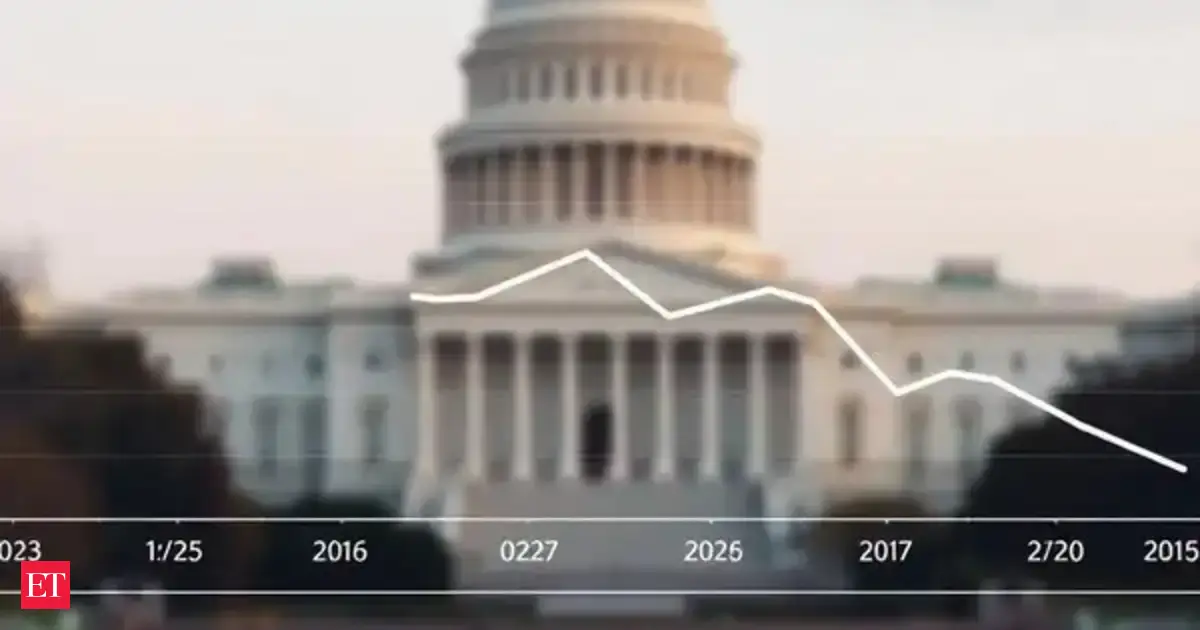Copyright indiatimes

22 states plus D.C. are in or near recession. Jobs slow, wages stagnate, housing softens. Regional weakness hits almost 90% of Americans, signaling a growing national economic concern. The Great American Slowdown: Nearly 9 in 10 live in states hit by recession. The numbers are stark. 22 states plus Washington D.C. are already in or near recession. That’s nearly 9 in 10 Americans living in areas where the economy is struggling. National GDP and unemployment may look stable, but the reality on the ground tells a different story.In many states, job growth is slowing, wages are stagnating, and housing markets are softening. Even families who feel financially secure may see fewer opportunities, tighter credit, and higher costs in everyday life. Industries like manufacturing, agriculture, and transportation are among the hardest hit, facing global demand issues, supply chain problems, and rising costs.Housing is also under pressure. Fewer people are moving, and construction has slowed. That hits jobs and local businesses that depend on the housing boom, from suppliers to service providers. States that once thrived on population growth or booming local economies are now treading water, and many are struggling to keep pace.The slowdown is not uniform. Some states are still growing, but the majority face real economic pressure. Local recessions affect almost everyone. Workers see fewer openings, smaller raises, and limited upward mobility. Families may hesitate on big purchases like homes or cars. Even renters face fewer new units and rising costs in certain regions.Businesses feel it too. Companies operating across multiple states see profits drop in weaker regions, even if national sales remain strong. Sectors tied to housing, manufacturing, and transportation are most vulnerable. Small businesses that rely on local consumers are particularly exposed. Many are adjusting hiring, budgets, and expansion plans to survive the slowdown.Live EventsPolicymakers have to pay attention. National indicators can hide local struggles. Targeted support, infrastructure investment, and economic incentives may be needed to stabilize affected areas. For individuals, awareness is key. Knowing that your state is slowing helps plan finances, save strategically, and prepare for potential job impacts.The uneven nature of this slowdown is crucial. While some states maintain growth, most face declining employment, softer personal income, and weaker housing markets. If more states slip further, national growth could be threatened. Families, workers, and businesses that act proactively will navigate the slowdown more successfully.This is the great American slowdown, and it’s affecting millions. It’s not just about GDP numbers—it’s about real people feeling the pinch, local economies under stress, and decisions being shaped by tougher times. The key takeaway: nearly 9 in 10 Americans live in states experiencing economic strain, and preparation is now more critical than ever.Why are so many states in trouble right now?The United States is facing a slowdown that feels more widespread than it appears at first glance. Even though national numbers like GDP growth and unemployment seem relatively stable, the reality in many states is different. Analysts estimate that 22 states, plus Washington D.C., are either in a recession or very close to one. That’s nearly half the country in terms of geography, but when population is considered, it translates to almost 9 in 10 Americans living in areas feeling the economic pinch.Why does this matter? Because even if the overall economy looks healthy, local conditions affect everyday life—jobs, wages, and housing markets. Many people in these states may already feel slower job growth, rising costs, or fewer opportunities. Households and businesses alike are starting to notice the cracks, which can ripple through national statistics if the slowdown continues.This uneven growth is one of the reasons the phrase “great American slowdown” has become so widely used. It’s not just about numbers; it’s about real families and communities facing financial challenges. Even states that seem fine on the surface may experience pressure if surrounding areas falter.Which industries are feeling the pinch the most?The slowdown is not hitting all sectors equally. States that rely heavily on manufacturing, agriculture, and transportation are seeing the sharpest declines. For example, regions with large factories or farms are struggling with global demand fluctuations, supply chain issues, and rising costs. These challenges reduce output, slow hiring, and create stress for local economies.Housing and construction are also weaker in many affected states. Fewer people are moving, and building new homes is slowing down. That hits jobs and local businesses that depend on construction, from suppliers to service providers.Even if some cities are thriving, these weaker sectors mean that many Americans feel financial stress in their daily lives. Workers may face fewer promotions or smaller raises, and families may feel less confident about spending. The slowdown in key industries can also ripple into other sectors, including retail, hospitality, and services.The slowdown is especially noticeable in states that had previously benefited from rapid growth. Places that saw population influx or booming housing markets are now treading water. The combination of slower migration and industry struggles makes the overall economic picture murkier than national headlines suggest.How does this affect households and families?For everyday Americans, this slowdown is very real. Families may notice fewer job openings, slower wage growth, or rising living costs. Even if someone’s personal finances are stable, the local economy can affect things like school budgets, public services, and local business opportunities.Many households may also feel nervous about big purchases like homes or cars. With housing markets slowing in several states, potential buyers might face tighter lending conditions or fewer options. At the same time, renters could see fewer new apartments being built, keeping rents high in certain areas.Families with older children or young adults may find that career opportunities are more limited, especially in states heavily dependent on manufacturing or agriculture. Even workers in service industries could feel the impact indirectly, as households tighten spending.The big takeaway is that regional slowdowns touch almost everyone, even if your personal situation hasn’t changed. Awareness is key: knowing that your state is experiencing slower growth can help you plan finances, manage expenses, and anticipate job changes.What about businesses—how should they respond?Businesses are also feeling the slowdown in ways that aren’t obvious from national reports. Companies that operate in multiple states need to pay attention to local economic conditions, not just nationwide averages. For example, a chain with stores in both thriving and struggling states may see profits drop in weaker regions, even if national sales seem steady.Companies tied to housing, construction, manufacturing, and transportation may be hit hardest. This includes suppliers, logistics companies, and service providers. Local weakness can reduce demand, delay projects, and affect cash flow. Businesses may need to adjust hiring plans, budgets, or expansion strategies based on state-specific trends rather than national reports.Small businesses are particularly vulnerable. Many rely on local consumers, and a slowdown in spending can create real financial strain. Even moderate changes in local employment or income can translate into fewer customers and lower revenue.Strategic planning is crucial. Businesses should monitor regional trends, diversify locations, and focus on cost management to weather the slowdown. Companies that act proactively can avoid surprises and position themselves for growth once conditions improve.What should policymakers and individuals watch for?The slowdown highlights the importance of state-level economic monitoring. While national statistics may appear stable, local recessions can expand if left unchecked. Policymakers may need to focus on targeted support, such as incentives for industries in decline, investments in infrastructure, or support for struggling households.For individuals, the key is awareness. Know your state’s economic health, track employment trends, and understand how housing and local industries are performing. Being informed allows families to make smarter decisions about jobs, spending, and savings.It’s also wise to prepare for uncertainty. Even if your personal finances are strong, a slowdown can affect everything from job security to cost of living. Budgeting carefully, saving where possible, and planning major purchases can make a difference during uncertain times.Finally, businesses and individuals alike should remember the uneven nature of the slowdown. Some states are still growing, while others are struggling. Being nimble and informed is the best way to navigate this period.What does this mean for the future?The “great American slowdown” is more than a statistic. It’s a real issue affecting millions of households, workers, and businesses. While the U.S. may not officially be in a national recession, the widespread regional weakness shows that many Americans are already feeling the impact.Monitoring employment trends, housing markets, and industry-specific indicators is critical. If enough states slip further, national growth could slow more dramatically. Individuals, families, and businesses that plan for these challenges will be better positioned to navigate the next phase of the economy.In short, this slowdown is not just about numbers on a page—it’s about everyday lives, local economies, and real decisions that millions of Americans face. Awareness, preparation, and smart planning are now more important than ever.Add as a Reliable and Trusted News Source Add Now! (You can now subscribe to our Economic Times WhatsApp channel) Read More News onGreat American Slowdown recession hitting 22 statesThe Great American Slowdown Hits Almost Everyonethe great american slowdownu.s. recession 2025housing market softmanufacturing declinewage stagnationregional economic weaknessamerican economy (Catch all the US News, UK News, Canada News, International Breaking News Events, and Latest News Updates on The Economic Times.) Download The Economic Times News App to get Daily International News Updates....moreless (You can now subscribe to our Economic Times WhatsApp channel)Read More News onGreat American Slowdown recession hitting 22 statesThe Great American Slowdown Hits Almost Everyonethe great american slowdownu.s. recession 2025housing market softmanufacturing declinewage stagnationregional economic weaknessamerican economy(Catch all the US News, UK News, Canada News, International Breaking News Events, and Latest News Updates on The Economic Times.) Download The Economic Times News App to get Daily International News Updates....moreless Explore More Stories123



